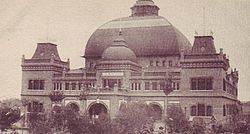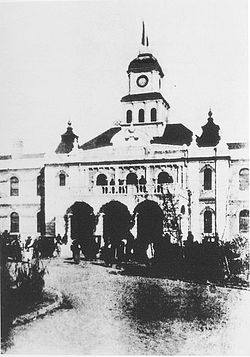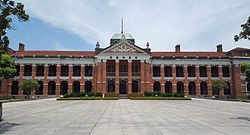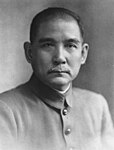1909 Chinese provincial elections
 | ||||||||||
| ||||||||||
1,643 seats in all Provincial Assemblies | ||||||||||
|---|---|---|---|---|---|---|---|---|---|---|
| Registered | ~1,700,000 | |||||||||
| Turnout | 10–20% | |||||||||
| ||||||||||
 Elections held No election | ||||||||||
The 1909 Chinese provincial elections were held to elect the members of the Provincial Assemblies (or Consultative Bureau) of China. The election was held between April and June 1909 in the 22 provinces of China as part of the New Policies as a move toward constitutional monarchy. The Provincial Assemblies were convened on 14 October 1909 and were responsible for electing half of the members of the imperial Advisory Council convened subsequently in 1910. These provincial assemblies survived even after the 1911 Xinhai Revolution that founded the Republic of China and replaced the Qing Empire. They were ordered to dissolve by the President Yuan Shikai.
About 1.7 million men, or 0.42 percent of a population of 410 million, were registered as eligible voters. It was marked as one of the most important episodes of Chinese democracy as "it [was] the first day in Chinese history that people can elect their representative," as promoted by newspaper Shi Pao, although a county council election in Tianjin had been held earlier in 1907.[1] The Constitutionalists gained grounds in the election and became more active in the constitutional movement pushing for the establishment of constitutional monarchy.
Background
By the early 1900s the Qing Empire was in serious decline. Its attempt at a "Hundred Days' Reform" by the young Guangxu Emperor was aborted after a coup by Empress Dowager Cixi and execution of the Six gentlemen of the Hundred Days' Reform.[1]
Around the same time, China experienced growing support for constitutional reform from Kang Youwei and Liang Qichao and others. Emerging media from the periphery began influencing the political center.[1]




In 1907, the Imperial Government promulgated the Constitutional Preparation Program that aimed to establish a National Assembly and 21 Provincial Assemblies on a provisional basis.[2] A Constitutional Commission was also established. In July 1908, the court promulgated the 62-clause "Regulations for Provincial Assemblies" and the 115-clause "Regulations for Provincial Assembly Elections" to lay out the property and education requirements for the candidates. On August 27 1908, the court announced the "Principles of the Constitution" and an eventual conversion to a constitutional monarchy.[1]
Electoral system
Per the 1908 “Regulations on Provincial Assemblies", voting was restricted to literate men over the age of 25. Additionally, a voter had to have been a native of their province who either had the equivalent of a Chinese or foreign Middle-school education, or possessed capital or properties worth at least 5,000 yuan, or had served as a seventh-rank civil official or fifth-rank military officer, or had a gongsheng level Imperial Civil Examination degree. Non-native residents could vote if they had lived in the province for at least ten years and owned property worth at least 10,000 yuan.[1]
However, certain individuals were disqualified from voting regardless of meeting the initial requirements. This included those perceived to have an "unsavory, selfish character, or presumptuous personality," individuals with criminal convictions or imprisonment records, those involved in "improper businesses" (a codeword for things like prostitution or the opium trade), individuals accused of financial misconduct, those from disreputable families, opium smokers, and the mentally ill. Additionally, voting rights were suspended for active officials or private secretaries to officials, active soldiers and reservists, police officers, religious clergy including Buddhist and Daoist priests, and current students.[1]
Like with Japanese elections, a candidate had to have been 30 years of age or older. Furthermore, elementary school teachers could not be elected, as serving in the assembly was thought to conflict with their teaching duties.[1]
These regulations sparked challenges and controversies from local governments and were consistently criticized by the press. Many terms were vague and contained "numerous points that were hard to make sense of." Often, the interpretations given by the Constitutional Commission contradicted the original regulations.[1]
The elections adopted the double voting system which was borrowed from Japan, in which the preliminary voting was to choose the electors who cast the second ballot to elect the fixed number of assembly members.[2]
Voter and membership statistics
| Province | Population | Voters | % | Seats |
|---|---|---|---|---|
| Zhili | 29,932,000 | 163,000 | 0.62 | 140 |
| Fengtian | 12,133,000 | 53,000 | 0.43 | 50 |
| Jilin | 5,580,000 | 15,000 | 0.27 | 30 |
| Heilongjiang | 2,029,000 | 5,000 | 0.23 | 30 |
| Shandong | 30,988,000 | 119,000 | 0.38 | 100 |
| Henan | 35,900,000 | – | – | 96 |
| Shanxi | 12,269,000 | 54,000 | 0.43 | 86 |
| Jiangsu | 32,283,000 | 162,000 | 0.50 | 121 |
| Anhui | 16,229,000 | 78,000 | 0.48 | 83 |
| Jiangxi | 23,987,000 | – | – | 93 |
| Fujian | 15,849,000 | 50,000 | 0.39 | 72 |
| Zhejiang | 21,440,000 | 90,070 | 0.42 | 114 |
| Hubei | 25,590,000 | 113,000 | 0.38 | 80 |
| Hunan | 27,390,000 | 100,000 | 0.36 | 82 |
| Shaanxi | 10,271,096 | 29,000 | 0.29 | 63 |
| Gansu | 4,990,000 | 9,000 | 0.19 | 43 |
| Xinjiang | — | — | — | — |
| Sichuan | 48,130,000 | 191,000 | 0.39 | 105 |
| Guangdong | 28,010,000 | 142,000 | 0.49 | 91 |
| Guangxi | 8,747,000 | 40,000 | 0.46 | 57 |
| Yunnan | 9,467,000 | – | – | 68 |
| Guizhou | 9,665,000 | 42,000 | 0.42 | 39 |
| Total | 410,879,096 | 1,700,000 | 0.42 | 1,643 |
Election results
The turnout of the election was only around 10 to 20 percent. Candidates in Northeastern China faced nearly no competition and was described as "handpicked" by the officials.[3]
90 percent of the gentry who had a traditional civil examination degree, in which the examination system was abolished in 1905, were elected. The average age of the elected members was 40. The Constitutionalists campaigned for the election and they were divided into different small factions by background and political beliefs. Among those elected who later became famous were Zhang Jian in Jiangsu, Tan Yankai in Hunan and Tang Hualong in Hubei who were all elected speakers for their respective assemblies and leaders of the constitutional movement.[4] Due to the double round system of voting which led to instances of bribery, corruption incidents were observed.[2]
The elected member of the provincial assemblies elected the 98 members, consisting of half of the seats, in the imperial Advisory Council. As the Constitutionalists gained grounds in the assemblies, they began to form different political groups and further pushed for the implementation of constitutional monarchy.
See also
- Democracy in China
- Provinces of China
- Preparative Constitutionalism
- 1909 Chinese parliamentary election
- 1912 Chinese National Assembly election
References
- ^ a b c d e f g h Chang, David Cheng (2011). "9. Democracy Is in Its Details: The 1909 Provincial Assembly Elections and the Print Media". Cornell University Press: 195–213 – via De Gruyter.
- ^ a b c Chang, P'eng-yuan. "Provincial Assemblies: The Emergence of Political Participation, 1909-1914".
{{cite journal}}: Cite journal requires|journal=(help) - ^ 張, 朋園. 立憲派與辛亥革命. pp. 17–22.
- ^ "昙花一现的"咨议局"". 中国共产党新闻.
- v
- t
- e
- Emperor
- List
- Family tree
- Advisory Council
- Amban
- Consultative Bureau
- Cup of Solid Gold
- Dates of establishment of diplomatic relations
- Da-Qing Bank
- Deliberative Council
- Diplomatic missions
- Flag of the Qing dynasty
- Grand Council
- Great Qing Legal Code
- Imperial Clan Court
- Imperial Commissioner
- Imperial Household Department
- Lifan Yuan
- Ministry of Posts and Communications
- Nine Gates Infantry Commander
- Provincial governor
- Provincial military commander
- Principles of the Constitution (1908)
- Royal and noble ranks of the Qing dynasty
- Viceroys
- Zongli Yamen
mausoleums
culture
- Booi Aha
- Changzhou School of Thought
- Complete Classics Collection of Ancient China
- Dibao
- Economy
- Four Wangs
- History of Ming
- Kangxi Dictionary
- Kaozheng
- Literary inquisition
- Manchu Han Imperial Feast
- Peiwen Yunfu
- Pentaglot Dictionary
- Qing official headwear
- Qing poetry
- Complete Tang Poems
- Queue
- Researches on Manchu Origins
- Sacred Edict of the Kangxi Emperor
- Shamanism during the Qing dynasty
- Islam during the Qing dynasty
- Complete Library of the Four Treasuries
- Treaty of Kyakhta (1727)
- Treaty of Nerchinsk
- Unequal treaty
- Boxer Protocol
- Burlingame Treaty
- Chefoo Convention
- Convention Between Great Britain and China Respecting Tibet
- Convention for the Extension of Hong Kong Territory
- Convention of Peking
- Convention of Tientsin
- Li–Lobanov Treaty
- Sino-Portuguese Treaty of Peking
- Treaty of Aigun
- Treaty of the Bogue
- Treaty of Canton
- Treaty of Kulja
- Treaty of Nanking
- Treaty of Saint Petersburg (1881)
- Treaty of Shimonoseki
- Treaty of Tarbagatai
- Treaty of Tientsin
- Treaty of Wanghia
- Treaty of Whampoa
| Coinage | |
|---|---|
| Paper money |
- Aisin Gioro
- Anti-Qing sentiment
- Canton System
- Chuang Guandong
- Draft History of Qing
- History of Qing (People's Republic)
- Imperial hunt of the Qing dynasty
- Legacy of the Qing dynasty
- Manchu people
- Names of the Qing dynasty
- New Qing History
- Timeline of late anti-Qing rebellions
- Treaty ports
- Willow Palisade













